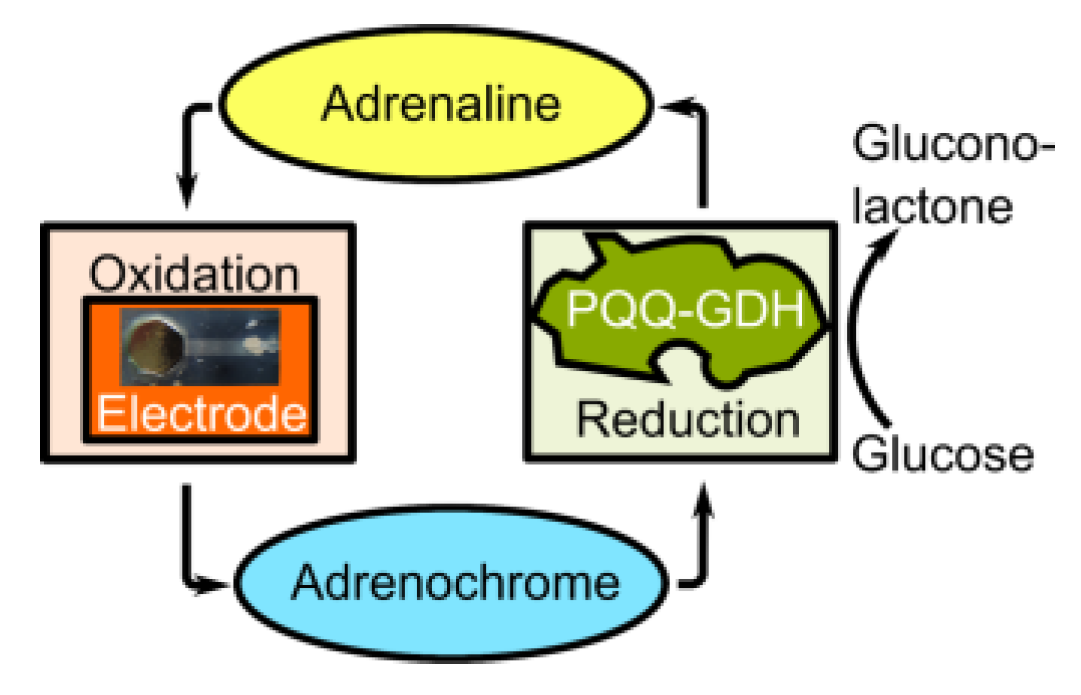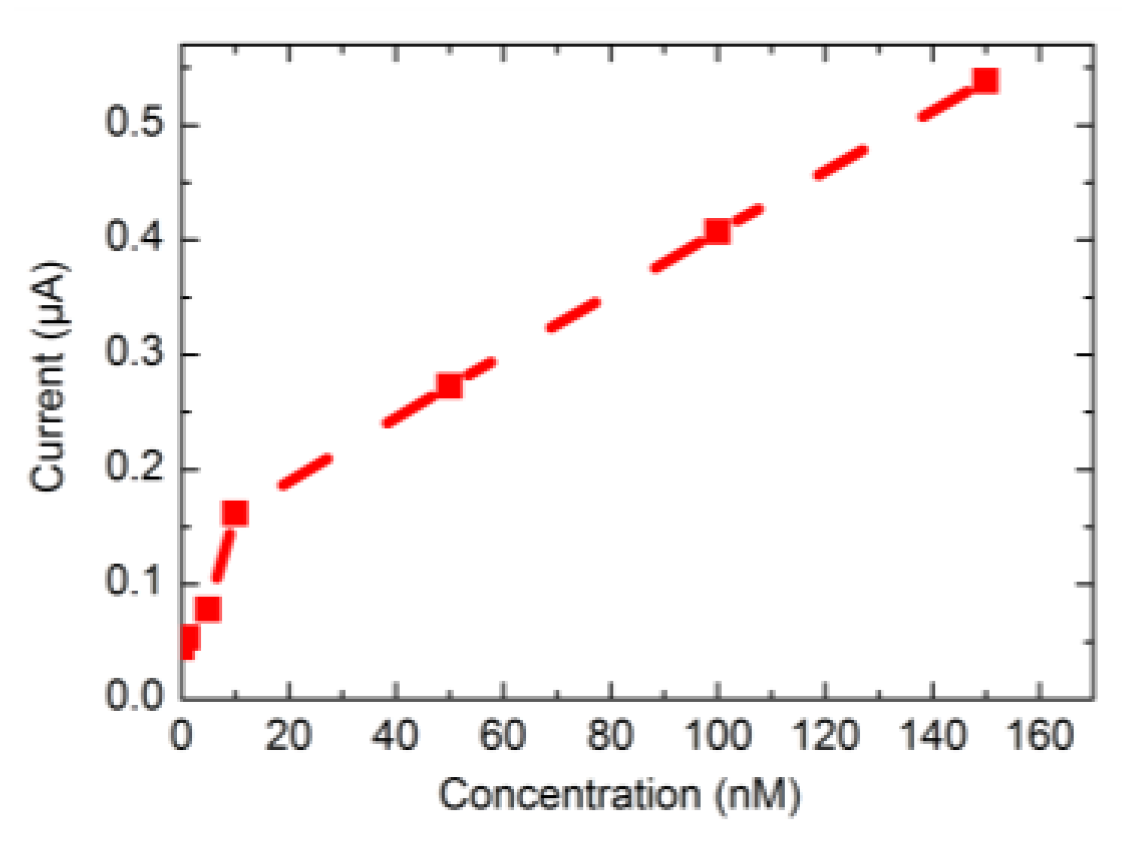Detection of Adrenaline Based on Bioelectrocatalytical System to Support Tumor Diagnostic Technology †
Abstract
:1. Introduction
2. Materials and Method
2.1. Chemicals
2.2. Preparation of the Adrenaline Biosensor
2.3. Electrochemical Sensor Characterization
3. Results and Discussion
4. Conclusions and Outlook
Acknowledgments
Conflicts of Interest
References
- Rossi, G.P.; Auchus, R.J.; Brown, M.; Lenders, J.W.M.; Naruse, M.; Plouin, P.F.; Satoh, F.; Young, W.F. An expert consensus statement on use of adrenal vein sampling for the subtyping of primary aldosteronism. Hypertension 2013, 63, 151–160. [Google Scholar] [CrossRef] [PubMed]
- Funder, J.W.; Carey, R.M.; Mantero, F.; Murad, M.H.; Reincke, M.; Shibata, H.; Stowasser, M.; Young, W.F., Jr. The management of primary aldosteronism: Case detection, diagnosis, and treatment: An endocrine society clinical practice guideline. J. Clin. Endocrinol. Metab. 2016, 101, 1889–1916. [Google Scholar] [PubMed]
- Catena, C.; Colussi, G.; Nadalini, E.; Chiuch, A.; Baroselli, S.; Lapenna, R.; Sechi, L.A. Cardiovascular outcomes in patients with primary aldosteronism after treatment. Arch. Intern. Med. 2008, 168, 80–85. [Google Scholar] [CrossRef] [PubMed]
- Stowasser, M.; Gordon, R.D. Primary aldosteronism—Careful investigation is essential and rewarding. Mol. Cell. Endocrinol. 2004, 217, 33–39. [Google Scholar] [CrossRef] [PubMed]
- Scheller, F.; Siegbahn, N.; Danielsson, B.; Mosbach, K. High-sensitivity enzyme thermistor determination of L-lactate by substrate recycling. Anal. Chem. 1985, 57, 1740–1743. [Google Scholar] [CrossRef]
- Cybulski, D.; Male, K.B.; Scharer, J.M.; Moo-Young, M.; Luong, J.H.T. Substrate recycling scheme for tetrachloro-p-benzoquinone using bilirubin oxidase and NADH: Application for pentachlorophenol assay. Environ. Sci. Technol. 1999, 33, 796–800. [Google Scholar] [CrossRef]
- Scheller, F.W.; Bauer, C.G.; Makower, A.; Wollenberger, U.; Warsinke, A.; Bier, F.F. Coupling of immunoassays with enzymatic recycling electrodes. Anal. Lett. 2001, 34, 1233–1245. [Google Scholar] [CrossRef]
- Mizutani, F.; Yabuki, S.; Asai, M. Highly-sensitive measurement of hydroquinone with an enzyme electrode. Biosens. Bioelectron. 1991, 6, 305–310. [Google Scholar] [CrossRef]
- Eremenko, A.; Makower, A.; Jin, W.; Rüger, P.; Scheller, F. Biosensor based on an enzyme modified electrode for highly-sensitive measurement of polyphenols. Biosens. Bioelectron. 1995, 10, 717–722. [Google Scholar] [CrossRef]
- Glucose-Dehydrogenase (PQQ-Dependent). Available online: http://www.sorachim.com/enzymes/glucose-dehydrogenase-pqq-dependent.html (accessed on 2 August 2017).
- Laurinavicius, V.; Razumiene, J.; Ramanavicius, A.; Ryabov, A.D. Wiring of PQQ-dehydrogenases. Biosens. Bioelectron. 2004, 20, 1217–1222. [Google Scholar] [CrossRef] [PubMed]



Publisher’s Note: MDPI stays neutral with regard to jurisdictional claims in published maps and institutional affiliations. |
© 2017 by the authors. Licensee MDPI, Basel, Switzerland. This article is an open access article distributed under the terms and conditions of the Creative Commons Attribution (CC BY) license (https://creativecommons.org/licenses/by/4.0/).
Share and Cite
Molinnus, D.; Hardt, G.; Käver, L.; Willenberg, H.S.; Poghossian, A.; Keusgen, M.; Schöning, M.J. Detection of Adrenaline Based on Bioelectrocatalytical System to Support Tumor Diagnostic Technology. Proceedings 2017, 1, 506. https://doi.org/10.3390/proceedings1040506
Molinnus D, Hardt G, Käver L, Willenberg HS, Poghossian A, Keusgen M, Schöning MJ. Detection of Adrenaline Based on Bioelectrocatalytical System to Support Tumor Diagnostic Technology. Proceedings. 2017; 1(4):506. https://doi.org/10.3390/proceedings1040506
Chicago/Turabian StyleMolinnus, Denise, Gabriel Hardt, Larissa Käver, Holger S. Willenberg, Arshak Poghossian, Michael Keusgen, and Michael J. Schöning. 2017. "Detection of Adrenaline Based on Bioelectrocatalytical System to Support Tumor Diagnostic Technology" Proceedings 1, no. 4: 506. https://doi.org/10.3390/proceedings1040506
APA StyleMolinnus, D., Hardt, G., Käver, L., Willenberg, H. S., Poghossian, A., Keusgen, M., & Schöning, M. J. (2017). Detection of Adrenaline Based on Bioelectrocatalytical System to Support Tumor Diagnostic Technology. Proceedings, 1(4), 506. https://doi.org/10.3390/proceedings1040506







